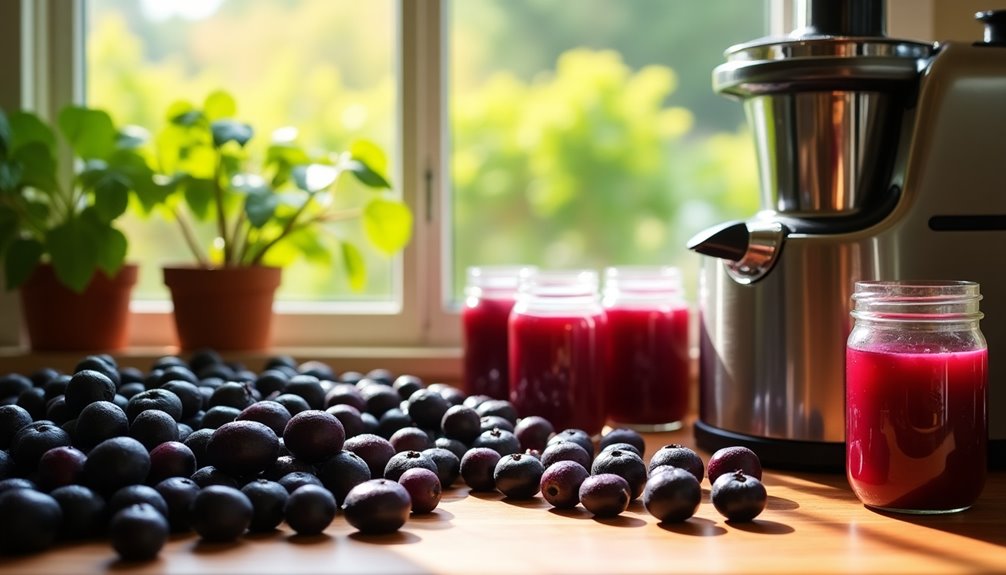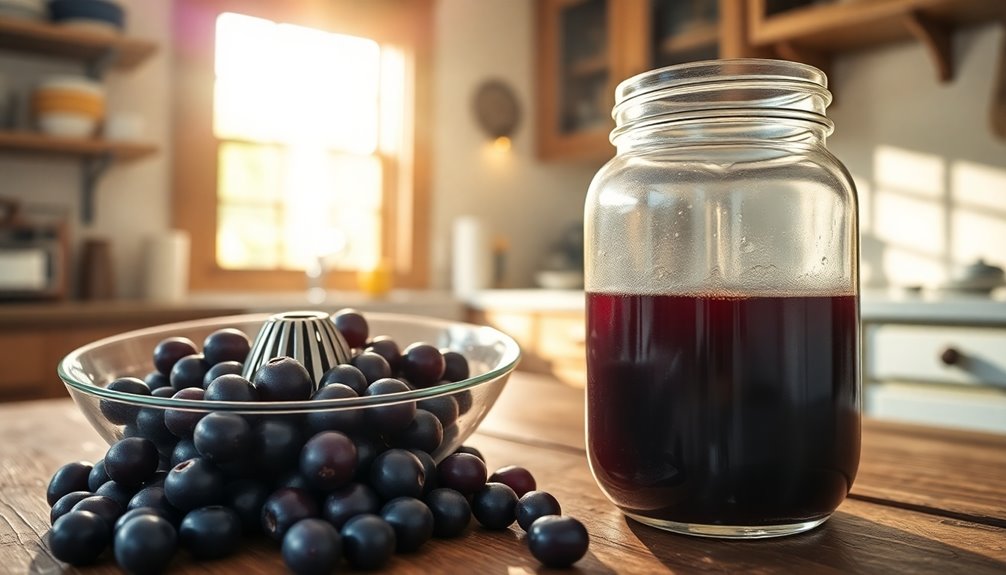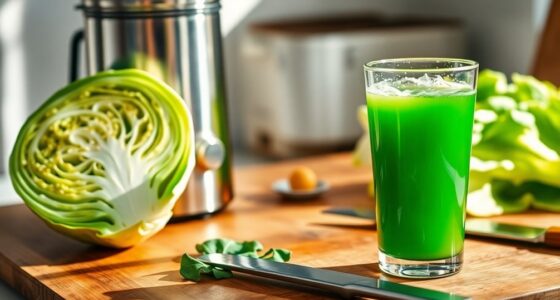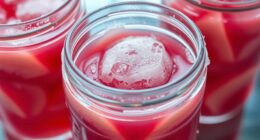To make muscadine juice, start by washing and sorting 36 pounds of grapes, removing the stems. Crush the grapes in a large stock pot, adding enough water to cover them. Bring the mixture to a boil, then simmer for about 15 minutes. Use a fine mesh strainer to separate the juice from solids. Pour the hot juice into hot canning jars, seal them, and process in a water bath for 10-15 minutes to preserve your delicious juice. You'll discover more tips along the way.
Key Takeaways
- Wash and sort 36 pounds of muscadine grapes, removing any stems before placing them in a large stock pot.
- Crush the grapes to release their juices, then add enough water to cover the crushed grapes.
- Bring the mixture to a boil, then reduce heat and simmer for about 15 minutes to infuse flavors.
- Strain the mixture using a fine mesh strainer or Foley food mill to separate the juice from seeds, stems, and skins.
- Pour hot juice into sterilized canning jars, seal, and process in a water bath canner for 10-15 minutes.

Making muscadine juice is a delightful way to enjoy the rich flavors of these unique grapes. If you're ready to dive into this tasty project, start by gathering your ingredients and tools. You'll need about 36 pounds of muscadine grapes, which will yield around 3-1/2 gallons of juice.
First, wash and sort through the grapes, removing any stems. It's essential to ensure that only the best grapes make it into your juice, so take your time with this step.
Once your muscadine grapes are clean, place them in a large stock pot. You'll want to crush the grapes to release their juices; a pastry cutter works well, or you can use a food processor for a quicker method.
After crushing, add enough water to just cover the grapes. This is where the magic begins! Bring the mixture to a boil over medium heat, allowing the natural sugars and flavors of the muscadine grapes to infuse into the water.
Once you reach a rolling boil, reduce the heat and cover the pot. Let the grapes simmer for about 15 minutes. During this time, the hulls will soften, and the rich aroma will fill your kitchen.
After the simmering, you'll need to let the mixture cool for a bit. It's important to handle hot liquids carefully, so give it a few moments before you move on to the next step.
Once the mixture has cooled, it’s time to extract the juice. You can use a fine mesh strainer or a Foley food mill for this process. Strain the mixture to separate the juice from the seeds, stems, and skins. This part is crucial for achieving that smooth and delicious juice you’re aiming for. Make sure to press firmly to extract as much juice as possible while ensuring that no solid remnants make their way into your final product. For those looking to maximize efficiency, juicing limes with a juicer can be a fantastic option, providing quick and consistent results. Once you’ve strained the mixture thoroughly, you can proceed to bottle your fresh juice, ready to be enjoyed or used in your favorite recipes.
After straining, you'll have your freshly extracted muscadine juice, ready for canning or refrigeration.
If you plan on preserving your juice, you'll want to use canning jars. Make sure your jars are hot to prevent breakage when you add the juice.
Pour the hot juice into the hot jars, leaving about a half-inch of headspace. After filling the jars, it's important to seal them properly. You can use a water bath canner for this. Process your jars in boiling water for about 10-15 minutes, which will help ensure they seal properly and can be stored for later use.
Once the processing time is up, carefully remove the jars from the bath canner and let them cool completely on a clean towel or cooling rack. As they cool, you'll hear the satisfying "pop" of the lids sealing.
Your homemade muscadine juice is now ready to enjoy! Whether you drink it fresh or use it for making jelly, you'll treasure the sweet taste of your hard work. Enjoy your refreshing creation!
Frequently Asked Questions
How Do You Make Juice From Muscadines?
To make juice from muscadines, start by washing and sorting your grapes.
Crush them with a pastry cutter or food processor.
Then, boil the crushed grapes in a large pot with enough water to cover them for about 30 minutes.
After boiling, strain the mixture through a fine mesh strainer to separate the juice from the solids.
You can sweeten it if you like, then store it properly for later use.
Can You Drink Muscadine Juice?
Yes, you can definitely drink muscadine juice! It's not only safe but also packed with flavor and antioxidants, making it a healthy choice.
You'll enjoy its unique taste, which sets it apart from regular table grapes. Plus, the juice may offer potential health benefits, like supporting heart health and boosting your immune system.
Whether you drink it fresh or use it in other products, muscadine juice is a delightful addition to your diet.
How Many Pounds of Muscadines Make a Gallon of Juice?
When you're savoring a delicious glass of juice, it's surprising to realize the effort behind that taste.
To make a gallon of muscadine juice, you'll need about 10.3 pounds of grapes. Depending on the grape variety and ripeness, your yield can vary, but this is a solid guideline.
How to Process Muscadine Grapes for Drinking?
To process muscadine grapes for drinking, start by washing and sorting about 8 cups of grapes.
Crush them using a pastry cutter or food processor, then add water to cover the mixture.
Bring it to a boil, reduce heat, and simmer for around 15 minutes.
After cooling, drain the juice through a Foley food mill, strain with cheesecloth, and finally, heat the juice to store in sterilized jars.
Enjoy your homemade juice!
Conclusion
Now that you know how to make muscadine juice, you're ready to dive in and enjoy this delicious treat! With just a few simple steps, you'll be sipping on a refreshing glass in no time. Just remember, the proof of the pudding is in the eating—so don't hesitate to share your homemade juice with friends and family. They'll be sure to appreciate the effort you put in, and you'll have them coming back for more!
Cindy thoroughly researches juicing trends, techniques, and recipes to provide readers with practical advice and inspiration. Her writing style is accessible, engaging, and designed to make complex concepts easy to understand. Cindy’s dedication to promoting the advantages of juicing shines through her work, empowering readers to make positive changes in their lives through the simple act of juicing.

















